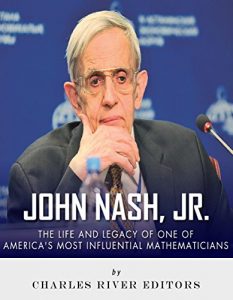*Includes pictures
*Includes Nash’s quotes about his own life and career
*Includes online resources and a bibliography for further reading
*Includes a table of contents
"In madness, I thought I was the most important person in the world.” – John Nash, Jr.
In 2001, the critically acclaimed film A Beautiful Mind introduced millions to John Nash, Jr., one of America’s most important 20th century mathematicians, nearly 50 years after he had won a Nobel prize for his work. Naturally, most viewers of the movie will remember a prodigy suffering from paranoid schizophrenia while overlooking how the man’s innovative studies and works had a major influence on everything from economics to biology, cryptography, artificial intelligence, and political philosophy. The “Nash equilibrium,” a theory he developed when he was still a student in his 20s, has also affected games, military doctrine, and computing.
Nash was still doing groundbreaking work and was in the prime of his life when he began demonstrating all kinds of odd behavior, initially alarming his wife Alicia and then stunning the academic world with an incoherent lecture in 1959. As it turned out, he was suffering from paranoid schizophrenia, which made him see things and believe in wild conspiracies like a national communist takeover by men wearing red ties. For nearly a decade after the diagnosis, Nash was treated in hospitals with various kinds of medication, including shock therapy, and Nash himself termed his mental health issues as making him go "from scientific rationality of thinking into the delusional thinking characteristic of persons who are psychiatrically diagnosed as 'schizophrenic' or 'paranoid schizophrenic'".
Over time, with a better understanding of the problem and treatment, Nash began to recover his mental faculties and get back to work in the last few decades of the 20th century. Fittingly, some of that work included coming up with hypotheses and theories about mental health issues, thereby having an impact on evolutionary psychology, and he was subsequently recognized with a countless number of awards for both his past and present work. Indeed, when he died in a car accident in May 2015 at the age of 86, he was returning from Norway, where he had been given the Abel Prize, awarded by the Norwegian government to outstanding mathematicians.
John Nash, Jr.: The Life and Legacy of One of America’s Most Influential Mathematicians chronicles the life and work of Nash and the impact he had on math and economics. Along with pictures of important people, places, and events, you will learn about Nash like never before.
*Includes Nash’s quotes about his own life and career
*Includes online resources and a bibliography for further reading
*Includes a table of contents
"In madness, I thought I was the most important person in the world.” – John Nash, Jr.
In 2001, the critically acclaimed film A Beautiful Mind introduced millions to John Nash, Jr., one of America’s most important 20th century mathematicians, nearly 50 years after he had won a Nobel prize for his work. Naturally, most viewers of the movie will remember a prodigy suffering from paranoid schizophrenia while overlooking how the man’s innovative studies and works had a major influence on everything from economics to biology, cryptography, artificial intelligence, and political philosophy. The “Nash equilibrium,” a theory he developed when he was still a student in his 20s, has also affected games, military doctrine, and computing.
Nash was still doing groundbreaking work and was in the prime of his life when he began demonstrating all kinds of odd behavior, initially alarming his wife Alicia and then stunning the academic world with an incoherent lecture in 1959. As it turned out, he was suffering from paranoid schizophrenia, which made him see things and believe in wild conspiracies like a national communist takeover by men wearing red ties. For nearly a decade after the diagnosis, Nash was treated in hospitals with various kinds of medication, including shock therapy, and Nash himself termed his mental health issues as making him go "from scientific rationality of thinking into the delusional thinking characteristic of persons who are psychiatrically diagnosed as 'schizophrenic' or 'paranoid schizophrenic'".
Over time, with a better understanding of the problem and treatment, Nash began to recover his mental faculties and get back to work in the last few decades of the 20th century. Fittingly, some of that work included coming up with hypotheses and theories about mental health issues, thereby having an impact on evolutionary psychology, and he was subsequently recognized with a countless number of awards for both his past and present work. Indeed, when he died in a car accident in May 2015 at the age of 86, he was returning from Norway, where he had been given the Abel Prize, awarded by the Norwegian government to outstanding mathematicians.
John Nash, Jr.: The Life and Legacy of One of America’s Most Influential Mathematicians chronicles the life and work of Nash and the impact he had on math and economics. Along with pictures of important people, places, and events, you will learn about Nash like never before.






